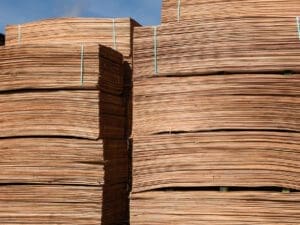When it comes to crafting beautiful and durable furniture, the choice of materials plays a critical role. Two popular options often considered by furniture makers and consumers alike are veneers and hardwood. Both materials offer distinct advantages and come with their own sets of considerations. This article will explore the differences between veneers and hardwood, highlighting their benefits, drawbacks, and ideal uses to help you make an informed decision when choosing furniture.
What are Veneers?
Veneers are thin slices of wood, typically thinner than 3mm, that are glued onto core panels (usually made of wood, particle board, or medium-density fiberboard) to produce flat panels such as doors, tops, and panels for cabinets, parquet floors, and parts of furniture. The primary reason for using veneers is to achieve the appearance of solid wood without the cost or weight.

Oak veneer in timber yard
Advantages of Veneers
- Cost-Effectiveness: Veneers are generally more affordable than solid hardwood. Because they use a thin layer of wood over a less expensive core material, they provide the aesthetic of solid wood without the high cost.
- Sustainability: Veneers are more sustainable than solid wood as they use less wood in their production. This can be a significant advantage for environmentally conscious consumers.
- Stability: Veneered furniture is less prone to warping and splitting compared to solid wood. The core materials used in veneers are often engineered to be stable and resistant to changes in temperature and humidity.
- Versatility in Design: Veneers can be produced from almost any type of wood, allowing for a vast array of colors, patterns, and textures. This flexibility enables designers to create intricate patterns and designs that might be difficult or impossible with solid wood.
- Lightweight: Veneered furniture tends to be lighter than solid wood furniture, making it easier to move and rearrange.
Drawbacks of Veneers
- Durability: While veneers are stable, they are not as durable as solid wood. They can be more susceptible to damage from sharp objects or heavy use. This is especially of veneers used in most high-street furniture stores where cheap furniture has been imported from Asia. It is less of an issue, if at all, with Irish Woodcraft Veneers as we use very high quality veneers up to 4mm thick.
- Repair Challenges: Veneers can be difficult to repair if they are damaged. Unlike solid wood, which can be sanded and refinished, veneers can only be sanded a few times before the underlying core material is exposed.
- Perceived Value: Some people perceive veneered furniture as being of lower quality compared to solid wood, which can affect the resale value of the furniture.
What is Hardwood?
Hardwood comes from deciduous trees that lose their leaves annually. These woods tend to be denser, which makes them ideal for furniture that needs to be durable and wear-resistant. Common hardwoods used in furniture making include oak, maple, cherry and walnut.

Bales of solid hardwood planks in timber yard
Advantages of Hardwood
- Durability and Longevity: Hardwood furniture is incredibly durable and can last for generations with proper care. It is more resistant to scratches, dents, and wear, making it an excellent choice for high-traffic areas.
- Repairability: One of the significant advantages of hardwood is that it can be easily repaired. Scratches and dents can be sanded out, and the wood can be refinished multiple times.
- Aesthetic Appeal: Many people prefer the natural look and feel of solid wood. Hardwood furniture often has a rich, warm appearance that can enhance the aesthetic of any room.
- Unique Characteristics: Each piece of hardwood furniture is unique, with its own grain patterns and colour variations. This uniqueness adds character and charm to the furniture.
- High Perceived Value: Solid hardwood furniture is often seen as high-quality and luxurious, which can add to the prestige and value of a piece.

Solid Walnut
Drawbacks of Hardwood
- Cost: Hardwood is generally more expensive than veneers. The cost of harvesting, processing, and crafting hardwood furniture is higher, making it a significant investment.
- Weight: Hardwood furniture can be very heavy, which can be a disadvantage if you need to move it frequently.
- Environmental Impact: The production of hardwood furniture can have a more significant environmental impact compared to veneers. Harvesting hardwood trees takes a toll on forests, although sustainable practices and certifications like FSC (Forest Stewardship Council) can mitigate this impact.
- Susceptibility to Environmental Changes: Solid wood can expand and contract with changes in humidity and temperature, leading to potential warping or cracking if not properly maintained.
When to Choose Veneers
Veneers are an excellent choice in several scenarios:
- Budget-Friendly Projects: If cost is a significant factor, veneers can offer a similar aesthetic to solid wood at a fraction of the price.
- Eco-Conscious Choices: For those looking to reduce their environmental footprint, veneers can be a more sustainable option, as they use less wood overall.
- Modern Designs: Veneers are ideal for modern and contemporary designs, where intricate patterns and exotic woods are desired.
- Lightweight Furniture: If you need furniture that is easy to move or rearrange, veneers are typically lighter than solid wood

Oak veneer. Oak texture. Spliced oak veneer on the table in the workshop. Close-up
When to Choose Hardwood
Hardwood is the preferred choice when:
Durability is Key: For pieces that will see heavy use, such as dining tables or office desks, the durability of hardwood is unmatched.
- Heirloom Quality: If you’re looking for a piece that can be passed down through generations, the longevity of hardwood makes it an excellent investment.
- Classic and Timeless Aesthetics: Hardwood is perfect for traditional designs where the beauty of natural wood is a focal point.
- High-Value Investment: For those willing to invest in high-quality furniture, the perceived value and longevity of hardwood can justify the cost.
Conclusion
The choice between veneers and hardwood for furniture ultimately depends on your needs, budget, and preferences. Veneers offer cost-effective and sustainable options with versatile designs, while hardwood provides unmatched durability, beauty, and a sense of prestige. Understanding the advantages and disadvantages of each material will help you make an informed decision that best suits your lifestyle and home decor.
Whether you choose the timeless elegance of hardwood or the modern versatility of veneers, both materials can be used to create stunning and functional furniture that will enhance your living space for years to come. Remember to consider factors like budget, intended use, and environmental impact when making your decision, ensuring that your furniture choice aligns with your values and needs.
It is important to note that the veneers we refer to in this article are our own Irish Woodcraft veneers. These are of extremely high quality. Once made correctly, it should only be the trained eye that can distinguish between furniture made with solid hardwood and hardwood veneers.





